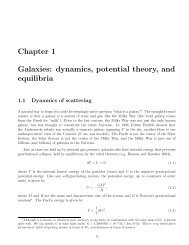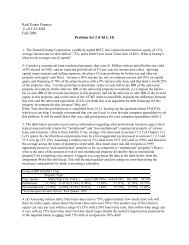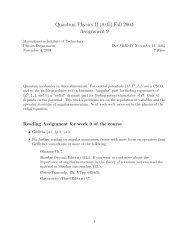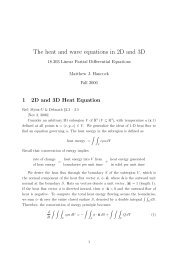Sean Faulk - MIT OpenCourseWare
Sean Faulk - MIT OpenCourseWare
Sean Faulk - MIT OpenCourseWare
Create successful ePaper yourself
Turn your PDF publications into a flip-book with our unique Google optimized e-Paper software.
4human-following mobile robot system, a path generator, and a number of other state-ofthe-artrobotic and sensory technologies. Proposed by the Hashimoto laboratory in theUniversity of Tokyo a few years ago, the concept of intelligent space has the ultimategoal of providing an interactive space that “comprehends human intentions and satisfiesthem.” It uses computer monitors to observe the clients and mobile robots to navigateabout the space and provide assistance. The space could be a room, corridor, or street,and is a cooperative system containing a network of computers and robots that has theability to learn and adapt through these distributed intelligent networked devices(DINDS). Its artificial spatial memory allows for the efficient exchange of informationand assistance between humans and the iSpace. Although it is well on its way, more workis being done on this revolutionary technology in order to turn it into an efficient,beneficial, and safe reality in the near future.But the increase in human-robot interaction and the further “humanizing” ofrobots fosters concern over the future. Will people be comfortable in a space under thecontrol and surveillance of robots at all times? Will humans that already perform assistivejobs such as doormen, waiters, and caretakers cease to exist? And will such humanconnection that we take for granted in these small situations be broken by this newtechnology? I think these are valid questions to consider before digging ourselves deeperand deeper into the hole of irreversible technological advances. The stories of TheMatrix, “Marriage a la Mode,” and countless others suggest that robotic technology coulddo damage to our society, and I agree that integration can create discomfort andemptiness among humans due to the vanishing of human-human interaction to make wayfor the robotic technology. Furthermore, as described in vast amounts of science fiction,Cite as: <strong>Sean</strong> <strong>Faulk</strong>. Course materials for 21W.730-5: Writing on Contemporary Issues: Imagining theFuture, Fall 2007. <strong>MIT</strong> <strong>OpenCourseWare</strong> (http://ocw.mit.edu/), Massachusetts Institute of Technology.Downloaded on [DD Month YYYY].
















